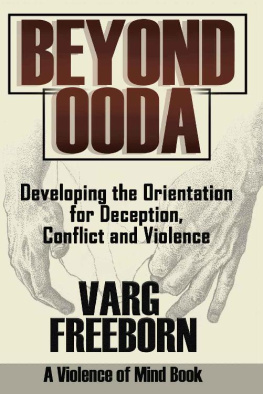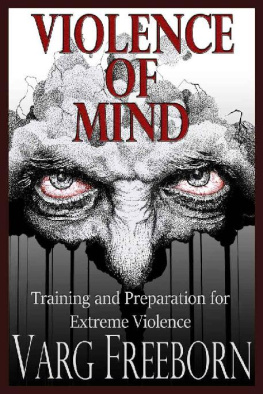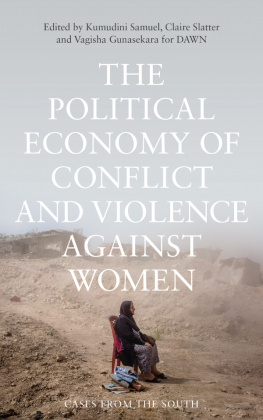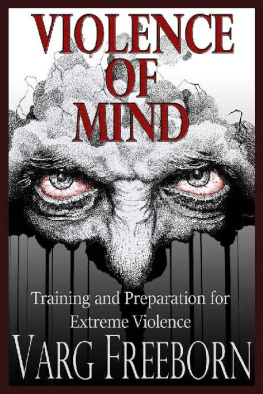Varg Freeborn - Beyond OODA: Developing the Orientation for Deception, Conflict and Violence
Here you can read online Varg Freeborn - Beyond OODA: Developing the Orientation for Deception, Conflict and Violence full text of the book (entire story) in english for free. Download pdf and epub, get meaning, cover and reviews about this ebook. year: 2021, publisher: Varg Freeborn, genre: Religion. Description of the work, (preface) as well as reviews are available. Best literature library LitArk.com created for fans of good reading and offers a wide selection of genres:
Romance novel
Science fiction
Adventure
Detective
Science
History
Home and family
Prose
Art
Politics
Computer
Non-fiction
Religion
Business
Children
Humor
Choose a favorite category and find really read worthwhile books. Enjoy immersion in the world of imagination, feel the emotions of the characters or learn something new for yourself, make an fascinating discovery.
- Book:Beyond OODA: Developing the Orientation for Deception, Conflict and Violence
- Author:
- Publisher:Varg Freeborn
- Genre:
- Year:2021
- Rating:4 / 5
- Favourites:Add to favourites
- Your mark:
- 80
- 1
- 2
- 3
- 4
- 5
Beyond OODA: Developing the Orientation for Deception, Conflict and Violence: summary, description and annotation
We offer to read an annotation, description, summary or preface (depends on what the author of the book "Beyond OODA: Developing the Orientation for Deception, Conflict and Violence" wrote himself). If you haven't found the necessary information about the book — write in the comments, we will try to find it.
Varg Freeborn: author's other books
Who wrote Beyond OODA: Developing the Orientation for Deception, Conflict and Violence? Find out the surname, the name of the author of the book and a list of all author's works by series.
Beyond OODA: Developing the Orientation for Deception, Conflict and Violence — read online for free the complete book (whole text) full work
Below is the text of the book, divided by pages. System saving the place of the last page read, allows you to conveniently read the book "Beyond OODA: Developing the Orientation for Deception, Conflict and Violence" online for free, without having to search again every time where you left off. Put a bookmark, and you can go to the page where you finished reading at any time.
Font size:
Interval:
Bookmark:
Beyond OODA:
Developing the Orientation for Deception, Conflict and Violence
A Violence of Mind Book
Copyright 2021 Varg Freeborn
Published by Varg Freeborn
All Rights Reserved
No part of this book may be reproduced or utilized in any form or by any means, electronic or mechanical, including photocopying, recording, or by any information storage and retrieval systems, without permission in writing from the author and publisher.
ISBN xxxxxxx
Varg Freeborn
www.vargfreeborn.com
Editing by Daniel Shaw
Cover Art and Design by Lorin Michki
Formatting by Lauren Bechtel
Other books by the author:
Violence of Mind: Training and Preparation for Extreme Violence
Special thanks to Chet Richards, who offered his feedback and took the time to put his stamp of approval on my interpretations of Boyds, and his work. That approval will forever remain a high point in my writing experience.
I would also like to thank Daniel and Lauren for their continued support of my projects, I know that hasnt always been an easy task.
Contents
Like my first book, Violence of Mind: Training and Preparation for Extreme Violence , I wrote this book to fill an information gap and offer a different perspective on violence mindset. Much of what I had read or heard being talked about in the training world on the subject of violence mindset, or combat mindset, was just desperately lacking key elements that I had experienced or observed first-hand .
I have shaped and refined the views expressed here based on what I have witnessed, experienced and participated in throughout my life. The thoughts I share here are my own, but I will not take credit for every concept I use since not much is new under the sun in the world of violence and combat. I simply have a less common background that allows me to develop a unique perspective on this crucial topic, and I feel compelled to share it for the good of others.
I have learned that fighters from very diverse backgrounds will often find themselves coming to similar (or the same) conclusions about how to fight or train, even though they are worlds apart in their backgrounds and experiences. There are only so many ways to be good at fighting, and human nature in force performance can be fairly predictable.
Mindset is the way you view yourself, the world around you and your position in that world at a given moment. As situations change and our environment becomes abnormal , reality can clash with our worldview and self-view, causing us to lose momentum in decision-making.
Orientation is what you bring to the fight, the source of all of the criteria that you use to make every decision. How you respond to emerging problems and information in real-time is based on your culture, attachments, moral values, experience, and confidence. These are the basis of what I refer to as our orientation, which forms that thing we call mindset. They control how we see ourselves and the world around us, which governs every decision we make. Your opponent has all of the same things, but his culture, experiences, and values sometimes cause him to come to different conclusions.
The biggest thing that we all seek to avoid is uncertainty since that is the nemesis of all fighters. Uncertainty is simply white space , a lack of answers or plans, a lack of the information needed to make a good decision. Uncertainty gets you killed. Some fill that white space with technical knowledge and training; others fill it with strong culture and values, often manifesting in extreme forms such as suicidal religious beliefs. Either way, your orientation is what fills that white space and is the most important part of determining how you will process information and make decisions in a fight.
It is also the quickest path to understanding the enemy. It is critical that you apply the two-way principle here: what governs you also governs the enemy. They have an orientation, and it is built from the same components. This enemy is most likely culturally different from you, so their orientation influences will be quite different than yours, hence why they come to different conclusions. But in general, the formula is the same.
It has been taught in warrior culture for thousands of years, to know yourself is to know your enemy, and only through conquering yourself can you achieve victory in defeating a dedicated opponent. This book will take a deep look at building a strong orientation that can be relied upon to construct the mindset needed when facing severe adversity in combat and other forms of adversity.
Heres my disclaimer: I am not a scientist, and this book is not full of data-driven science. I caution you about the popular trend of only valuing science in the study of training and violence. The study of violence in the ways that we need it studied has not been done in any scientifically significant way. Violence is too widespread, too random and too often not reported, or is reported inaccurately. And lets not forget that there is no way to quantify the characteristics of a mindset reliably.
As Joseph Campbell points out in his Pathways to Bliss , You can always tell an author who is still working under the authorities by the number of footnotes he provides to his text. You must have the courage of your own belief and leave it to somebody else to verify your authority for him or herself.
We should not discount the anecdotal evidence of the survivors or the past offenders of violence, nor should we ignore the perspectives of the participants and veterans of it who go on to become thinkers and developers in the business of violence training.
It would also be a mistake to discount my words due to my apparent lack of formal education or command of the written word. If you did, you would miss a first-hand account and a laymans analysis of the extreme violence and force performance I have seen and participated in. That participation went on for decades before developing and testing these concepts over years of training and teaching others in the application of force under the threat of harm or death.
I am a survivor of violence and poverty, and my lineage is generations deep in the experiences of savagery. I went on to be trained extensively as an instructor for civilians and law enforcement. I have done many of the things I will speak about in this book firsthand, and thats more than you can say for the average academic, as pretty as their prose may be. These are just my views, my experienced conclusions and conjecture, and I am sharing them with you for your considerations. Take it or leave it.
From the onset, I would also like to state that not all felons are predators, nor are they necessarily bad people. I am not characterizing an entire group in a general way. I am a felon, and I certainly would not perpetuate the legalized discrimination that has been leveraged against me many times in my life.
The U.S. locks up more people per capita than any other modernized country in the world. The popular estimate of the number of Americans with a felony in their past is around 20 million. Its not that hard to become a felon in the U.S., and most of you reading this have committed (or nearly committed) a felony in your lifetime; you just didnt get caught. In this work, I am discussing the specific subset of felons, and non-felons, who are dangerous to society.
I hope you find value in the pages that will follow. Any advantage you gain could be the one that saves your life or the life of someone you want to protect.
Section I
Origins: Part I
1:1.The Importance of Orientation for Mindset
The values, attachments and parameters that we use to make every decision ultimately influence our thoughts about an event. We can begin to break down those decision influencers as follows:
Font size:
Interval:
Bookmark:
Similar books «Beyond OODA: Developing the Orientation for Deception, Conflict and Violence»
Look at similar books to Beyond OODA: Developing the Orientation for Deception, Conflict and Violence. We have selected literature similar in name and meaning in the hope of providing readers with more options to find new, interesting, not yet read works.
Discussion, reviews of the book Beyond OODA: Developing the Orientation for Deception, Conflict and Violence and just readers' own opinions. Leave your comments, write what you think about the work, its meaning or the main characters. Specify what exactly you liked and what you didn't like, and why you think so.









